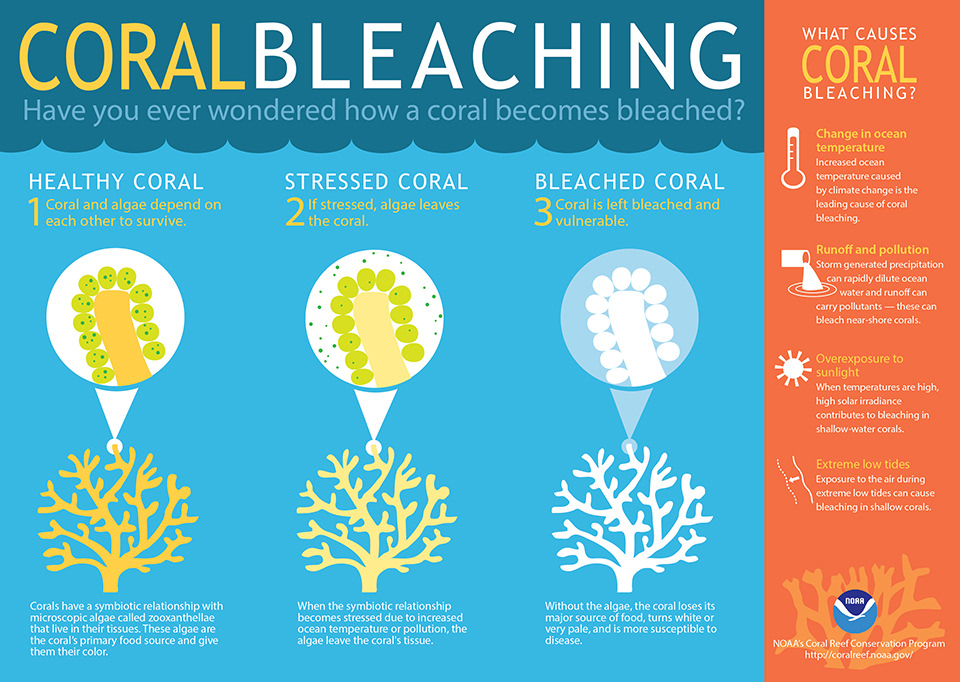Mike Huckabee, a presidential candidate of the Republican Party in the United States, recently stated that he believes global warming to be of minimal concern — nothing but a mild sunburn. But in reality, this “sunburn” is claiming lives, and destroying critical habitat. Anyone who doesn’t believe global warming is a threat, should take a moment to observe the changes happening to our oceans and reconsider.
They believe climate change is a greater threat than Islamic extremism, that a sunburn is worse than a beheading. It’s nonsense! #DemDebate
— Gov. Mike Huckabee (@GovMikeHuckabee) October 14, 2015
In 2014 massive coral bleaching events began to occur, damaging reefs across the North Pacific Ocean. This bleaching has continued, and is expected to affect nearly 40% of reefs globally by the end of 2015. Coral bleaching is a process that occurs when corals become stressed. Corals are primarily colonial organisms, actually closely related to anemones, which often secrete a calcareous exoskeleton and have a symbiotic relationship with microalgae called zooxanthellae. When corals are exposed to stressors such as rising temperatures or pollution, the zooxanthellae leave, depriving the coral polyps of their primary food source. Corals are not dead at this point, the white appearance of bleached corals is due to the absence of symbiotic algae, but take months to recover, if at all, and can only do so after the stress has subsided.


The National Oceanic and Atmospheric Administration (NOAA) based out of the United States recently declared this to be a global coral bleaching event, only the third such recorded global event. The first bleaching occurred in 1998, followed by another in 2010 before the current bleaching began in 2014, which is predicted to be the most severe bleaching yet. With bleaching events happening closer together, this reduces the amount of time that the coral may have to recuperate, and with this event expected to last into 2016 many reefs are expected die off entirely as they will be unable to recover.

This could have devastating effects that reach far beyond the loss of our charismatic friends the corals. Coral reefs can be likened to the rainforests of the sea, with high biodiversity and productivity. Reefs provide critical habitat for many species of invertebrates, fish, and reptiles such as snakes and turtles. They are important feeding areas for more transient visitors such as sea birds and marine mammals as well. Losing the corals would have far reaching impacts on all of the animals that depend on them for survival. Furthermore, the loss of coral reefs could have directly devastating effects on humans. Reefs create a wave barrier, protecting coastlines from erosion and tropical storms. Healthy reefs are also essential to maintaining healthy fish stocks, which many communities depend on for food and livelihood.

The current bleaching event has spread from the North Pacific, down to the South Pacific, and the Indian Ocean. The Great Barrier Reef off the coast of Australia, the largest reef system in the world, is beginning to show signs of being affected as well. With additional factors such as the El Niño, and “The Blob” of 2˚C warmer water in the North Pacific exacerbating warming trends, reefs around the world are threatened. While some promising measures to conserve and restore reefs are underway, such as marine protected areas and artificial reef installments, these cannot protect the corals from global and local temperature increases. Anyone who believes global warming is a gimmick needs to take a look at the facts. Human activity is the driving cause of climate change, and we need to take responsibility and clean up our act.
Check out the Global Coral Bleaching website, and NOAA’s Coral Reef Watch for more photos and interactive information on the bleaching event.

Video – citizen scientists learning how to assess coral bleaching
References:
Gattuso, J.-P., Magnan, A., Billé, R., Cheung, W. W. L., Howes, E. L., Joos, F., … Turley, C. (2015). Contrasting futures for ocean and society from different anthropogenic CO2 emissions scenarios. Science (New York, N.Y.), 349(6243), 4722. http://doi.org/10.1126/science.aac4722
Graham, N. A. J., Jennings, S., MacNeil, M. A., Mouillot, D., & Wilson, S. K. (2015). Predicting climate-driven regime shifts versus rebound potential in coral reefs. Nature. http://doi.org/10.1038/nature14140
Hoegh-Guldberg, O. (1999). Climate Change, coral bleaching and the future of the world’ s coral reefs. Symbiosis, 48. http://doi.org/10.1071/MF99078
Howes, E. L., Joos, F., Eakin, C. M., & Gattuso, J.-P. (2015). An updated synthesis of the observed and projected impacts of climate change on the chemical, physical and biological processes in the oceans. Frontiers in Marine Science, 2. http://doi.org/10.3389/fmars.2015.00036